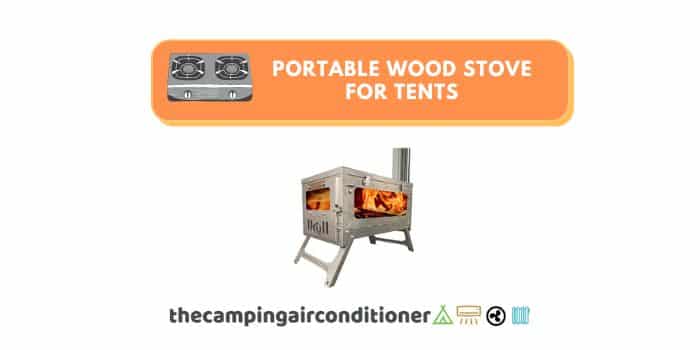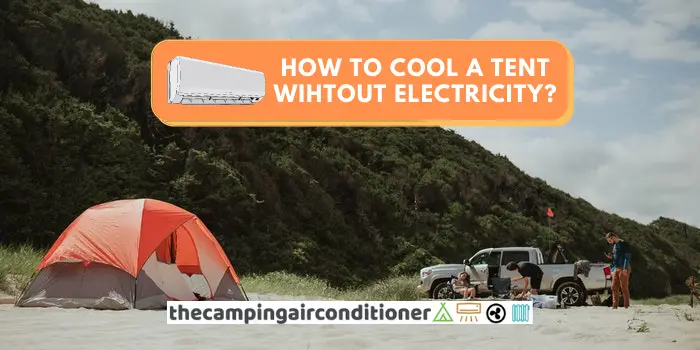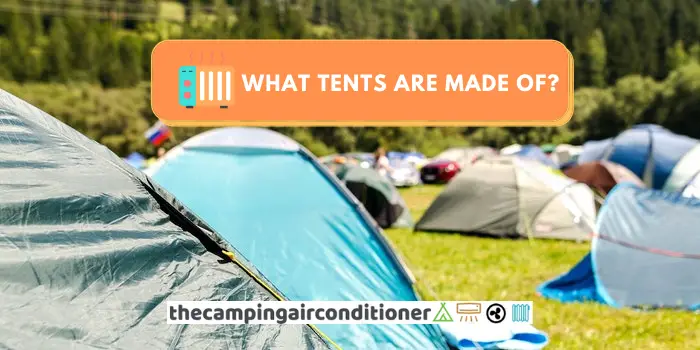Wood stoves are known for their efficiency, heating output, and charming environment that they create. Many campers still love this alternative to keep their tents hot and cozy during winter and freezing days.
But what are the best portable wood stove tents available in the market today? Our preferred options are:
a)Winnerwell Woodlander Large Tent Stove – Best Overall (Medium to Large Tents)
b) Firebox Wood/Multifuel stove – Best for backpackers and hikers
c) Winnerwell Nomad Small Tent Wood Stove – Best for small to medium tents
d) GBU Tent Wood Stove Budget Friendly for small-to-medium tents
Before going through a detailed review of each product, let’s first understand the benefits, drawbacks, risks, and advantages of portable wood stoves.

By the way, The Camping Air Conditioner is sponsored by readers. When you buy through one of our links, we may earn an affiliate commission at no extra cost to you.
What are hot tents?
A hot tent might be the ultimate solution for your winter days camping! They are shelters especially manufactured to accommodate a stove inside them.
Hot tents usually come with unique features to ensure maximum safety, such as a stove jack allowing hot air exhaustion through a specific chimney – check out our reviews of the best tents with stoves jacks.
If you are considering using one on your next trip, ensure you check the following:
- Ensure the chimney opening is robust and has proper insulation/space (you don’t want the chimney to be constantly in touch with the tent fabric since it can lead to overheating risks).
- Preferably, choose a tent with excellent breathability and a few openings to improve ventilation and minimise condensation risks. Canvas-cotton tents are a great alternative.
Can I use a portable wood stove in a tent?
Yes, you can. However, you should be aware of some risks and take preventive measures before doing so. We can highlight carbon monoxide poisoning and starting a fire in your tent among the biggest dangers!
Let’s analyze the principal risks of using a wood stove in your tent and how to mitigate them below.
Risk #1 - Carbon Monoxide Poisoning (and how to mitigate it)
Monoxide Carbon (CO) is a dangerous substance released in many combustion processes. Being colorless, odorless, and tasteless, you can easily get poisoned without noticing it.
Prolonged exposure to high levels of CO can cause fatigue, shortness of breath, blurred vision, vomiting, and even death in the worst-case scenario.
The human body can handle concentration levels below 70ppm (parts per million); however, as CO accumulates in the air, some initial poisoning effects can be felt, such as nausea and difficulty of breathing.
Levels above 150ppm are considered extremely dangerous and can lead to disorientation and ultimately death if no corrective action is taken.
So how to mitigate this risk when using a stove inside your tent?
Simple: ensure there is good air circulation and use a tent with a stove jack, such as White Duck Regatta Canvas Bell Tent. The main advantage of tents with stove jacks is that they already have the required infrastructure (openings to the chimney, insulation, adequate fabric, etc.) to install and use your stove and ensure CO levels are kept low.
If you are still concerned with it, we suggest using a portable smart CO monitor, and, in case you note increased concentration, open tent doors/windows and turn off the stove.
Risk #2 - Fire on your tent (and how to mitigate it)
You must be careful when using a stove inside your tent. Even though most portable wood stoves provide reasonable fire insulation, there is always the risk of starting a fire with flammable gear.
Our recommendation here is to remove any material that might easily ignite or overheat before using your wood stove, such as cloths, paper, fuel, etc. Also, always choose tents with fireproof or retardant features and always have a portable fire extinguisher around in an emergency.
To be on the safe side, we also recommend using a fire mat below your stove and ALWAYS using heat resistant gloves to move it around, such as Aillary heat resistant gloves.
Portable wood stove for tents - Our recommendations
After a thorough review of options available in the market, we chose these 04 models as the preferred options:
a)Winnerwell Woodlander Large Tent Stove – Best Overall (Medium to Large Tents)
b) Firebox Wood/Multifuel stove – Best for backpackers and hikers
c) Winnerwell Nomad Small Tent Wood Stove – Best for small to medium tents
d) GBU Tent Wood Stove Budget Friendly for small-to-medium tents
Winnerwell Woodlander Large Tent Stove - Best Overall
Winnerwell Woodlander Large Tent Stove is made of stainless steel (marine grade 304), ensuring robustness and a long life span – you will never see any sign of rust on it.
It is ideal for heating and cooking in medium to large tents, given its 1500 cubic feet firebox – it should easily heat tents with up to 10 people.
The stove comes with 1 stove body, 5 sections of 3.5 inch diameter chimney pipe and each pipe section is 17 inches long (approx. 43cm), 1 spark arrestor, and 1 ash scraper. It also already comes with a damper to facilitate use and maintenance.
Other features to highlight include a glass viewing window in the door for ambience and fire management, folding side shelves for cooking utility, dual dampers for controlling burn rate, a removable cooktop plate, and decorative steel handles.
Pros
- Superior quality (Stainless steel – marine grade 304)
- Can heat big tents
- Great design and easy to set up
Cons
- Weigh 30 pounds (heavier than other options)
- Pricey (but worth the investment)
Firebox Wood/Multifuel stove - Best for backpackers and hikers
Firebox Wood/Multifuel stove is a small and versatile camping stove kit that comes with a removable Ash Pan, four Firesticks, a Boil Plate, Adjustable Fire Grate and an Extended Grill Plate.
Weighing only 2.7 pounds and being demountable, it is ideal for backpackers and hikers. It is also made of stainless steel, which ensures robustness and durability. Even though it is small and compact, it can boil 2 cups of water in less than 3 minutes!
One of its advantages is that it is genuinely foldable (with hinged panels), meaning there is no need to assemble it. Its multiple plates and smart design allow you to run it with charcoal and wood or even use a small gas burner.
The video below details how can you use this incredible device.
Pros
- Lightweight
- Robust
- Versatile and easy to carry around
- Easy to set up and clean
- Runs from different fuel sources
- Can be used as an oven
Cons
- Does not come with chimney (not ideal to use inside your tent
- Pricey when compared to small portable butane stoves
Winnerwell Nomad Small Tent Wood Stove - Best for small to medium tents
Winnerwell Nomad Stove is the younger brother of Winnerwell Woodlander. It is also made of top stainless steel material, but ideal for small to medium tents – we recommend using it with tents up to 6 campers.
It comes with one stove body, five sections of 2.1-inch diameter chimney pipe, one spark arrestor, and one ash scraper. The Winnerwell Nomad Stove differs from the woodlander stoves due to its rectangle-shaped firebox and four-leg support design, which makes it smaller and more compact.
The chimney pipe sections stow inside the stove body, and the side shelves double as a carry handle. Weighing only 14.1 pounds, the Winnerwell Nomad Stove was built to ensure portability and ease of use.
Pros
- Durability
- Great design
- Heats small to medium tents well
- 4-leg support (more stability)
Cons
- None identified
GBU Tent Wood Stove - Budget Friendly for small-to-medium tents
GBU Tent Wood Stove is an affordable and efficient option during your winter camping adventures. The stove body is made of iron with a special coating, and it comes with stainless steel chimney pipes.
It works well for small and medium-sized tents (we recommend up to 6 people). It comes with four collapsible legs that make it foldable and easy to transport (it only weighs 16.3lbs).
As far as we are talking about prices, it costs considerably less than winnerwell options (approximately 50%) and provides a great heating output. However, some campers have raised some concerns with durability.
Pros
- Good value for money
- Comes with chimney and lateral support for cooking appliances
- Lightweight
Cons
- Some concerns around durability
Can you put a stove in any tent?
Overall, we do not recommend using a stove inside a standard tent. If you need to use it because of weather conditions or any other restrictions, make sure you put in place some safety measures, such as:
- Ensure there is plenty of ventilation in your tent
- Remove or isolate any flammable material
- Use a fire mat below your stove
- Consider an electric stove alternative
We have prepared an article detailing some tips to do it – read it here – everything you need to know to use a stove in a tent. After all, we still think that a tent with a stove jack will be the BEST OPTION.
Can I turn a regular tent into a hot tent?
Theoretically, yes, you can! You can add a stove jack to a tent, such as Danchel Stove Jack, and use it as a hot tent.
Theoretically, yes, you can! You can add a stove jack to a tent, such as Danchel Stove Jack, and use it as a hot tent.
Even though you will have the role and space for a chimney to pass through it, you might be still exposed to fire hazards risks if your tent fabric is highly flammable.
Therefore, before considering this approach, revisit your tent fabric characteristics and check whether it has any kind of fire protection (i.e. fire protection coating or CPAI-84 certification – see below). As a rule of thumb, canvas tents tend to have lower flammability.
Check whether your tent has the CPAI-84 certification – CPAI-84 is a flammability specification created by the Industrial Fabrics Association International to certify fabrics with minimal protection against fire.
Where to put a stove in a tent?
We recommend placing it in the tent’s centre and as far as it can be from tent walls and any camping gear inside your tent. Preferably, place it in a position with plenty of air circulation.
As previously advised, remove any flammable materials from inside your tent to eliminate fire ignition risks.
How do I heat my tent without a stove?
You can use a tent heater. There are plenty of options available in the market, such as:
- Propane Heaters (gas heaters)
- Butane Heaters (gas heater)
- Kerosene Heaters (liquid heater)
- Electric Heaters
- DIY Tent Heater (Candle Heater)
We wrote an article with all types of heaters that can be used in a tent and safety tips to ensure proper use – read it here.
What kind of woods burns the hotest?
Overall, Ash, red oak, white oak, beech, birch, hickory, hard maple, pecan and dogwood are excellent alternatives and burn faster.
Verdict
Our preferred portable wood stoves for tents are both Winnerwell models (Winnerwell Nomad Stove – best for small and medium-sized tents and Winnerwell Woodlander – best for medium to large tents). Both are made with marine grade stainless steel, which provides excellent robustness and durability.
However, GBU Tent Wood Stove is still an outstanding choice with great features and heating output for medium-sized tents if you are running on a budget.
On the other hand, if you are after something compact and ideal for your hike, our choice would be Firebox Wood/Multifuel stove – it comes with unique versatility and the ability to run from different fuel sources.










